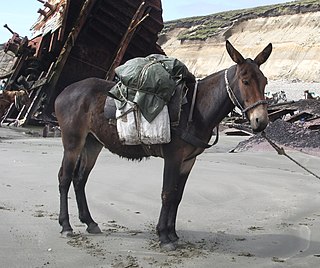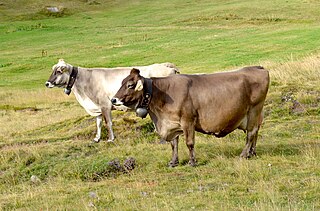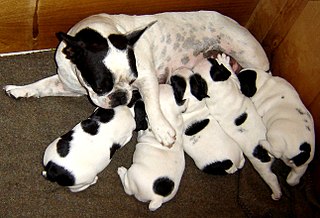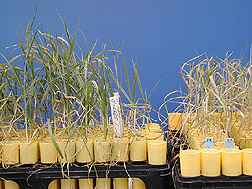Related Research Articles

In biology, a hybrid is the offspring resulting from combining the qualities of two organisms of different varieties, subspecies, species or genera through sexual reproduction. Generally, it means that each cell has genetic material from two different organisms, whereas an individual where some cells are derived from a different organism is called a chimera. Hybrids are not always intermediates between their parents such as in blending inheritance, but can show hybrid vigor, sometimes growing larger or taller than either parent. The concept of a hybrid is interpreted differently in animal and plant breeding, where there is interest in the individual parentage. In genetics, attention is focused on the numbers of chromosomes. In taxonomy, a key question is how closely related the parent species are.

Inbreeding is the production of offspring from the mating or breeding of individuals or organisms that are closely related genetically. By analogy, the term is used in human reproduction, but more commonly refers to the genetic disorders and other consequences that may arise from expression of deleterious recessive traits resulting from incestuous sexual relationships and consanguinity. Animals avoid inbreeding only rarely.

Ex situ conservation is the process of protecting an endangered species, variety, or breed of plant or animal outside its natural habitat. For example, by removing part of the population from a threatened habitat and placing it in a new location, an artificial environment which is similar to the natural habitat of the respective animal and within the care of humans, such as a zoological park or wildlife sanctuary. The degree to which humans control or modify the natural dynamics of the managed population varies widely, and this may include alteration of living environments, reproductive patterns, access to resources, and protection from predation and mortality.

A breed is a specific group of breedable domestic animals having homogeneous appearance (phenotype), homogeneous behavior, and/or other characteristics that distinguish it from other organisms of the same species. In literature, there exist several slightly deviating definitions. Breeds are formed through genetic isolation and either natural adaptation to the environment or selective breeding, or a combination of the two. Despite the centrality of the idea of "breeds" to animal husbandry and agriculture, no single, scientifically accepted definition of the term exists. A breed is therefore not an objective or biologically verifiable classification but is instead a term of art amongst groups of breeders who share a consensus around what qualities make some members of a given species members of a nameable subset.

Genetic diversity is the total number of genetic characteristics in the genetic makeup of a species. It ranges widely, from the number of species to differences within species, and can be correlated to the span of survival for a species. It is distinguished from genetic variability, which describes the tendency of genetic characteristics to vary.

Dog breeding is the practice of mating selected dogs with the intention of maintaining or producing specific qualities and characteristics. When dogs reproduce without such human intervention, their offspring's characteristics are determined by natural selection, while "dog breeding" refers specifically to the artificial selection of dogs, in which dogs are intentionally bred by their owners. Breeding relies on the science of genetics, hence a breeder who is knowledgeable on canine genetics, health, and the intended purpose of the dogs attempts to breed suitable dogs.
Heterosis, hybrid vigor, or outbreeding enhancement is the improved or increased function of any biological quality in a hybrid offspring. An offspring is heterotic if its traits are enhanced as a result of mixing the genetic contributions of its parents. The heterotic offspring often has traits that are more than the simple addition of the parents' traits, and can be explained by Mendelian or non-Mendelian inheritance. Typical heterotic/hybrid traits of interest in agriculture are higher yield, quicker maturity, stability, drought tolerance etc.
F1 hybrid (also known as filial 1 hybrid) is the first filial generation of offspring of distinctly different parental types. F1 hybrids are used in genetics, and in selective breeding, where the term F1 crossbreed may be used. The term is sometimes written with a subscript, as F1 hybrid. Subsequent generations are called F2, F3, etc.

Tree breeding is the application of genetic, reproductive biology and economics principles to the genetic improvement and management of forest trees. In contrast to the selective breeding of livestock, arable crops, and horticultural flowers over the last few centuries, the breeding of trees, with the exception of fruit trees, is a relatively recent occurrence.

Sewall Green Wright FRS (For) Honorary FRSE was an American geneticist known for his influential work on evolutionary theory and also for his work on path analysis. He was a founder of population genetics alongside Ronald Fisher and J. B. S. Haldane, which was a major step in the development of the modern synthesis combining genetics with evolution. He discovered the inbreeding coefficient and methods of computing it in pedigree animals. He extended this work to populations, computing the amount of inbreeding between members of populations as a result of random genetic drift, and along with Fisher he pioneered methods for computing the distribution of gene frequencies among populations as a result of the interaction of natural selection, mutation, migration and genetic drift. Wright also made major contributions to mammalian and biochemical genetics.
Deborah Charlesworth is a population geneticist from the UK, notable for her important discoveries in population genetics and evolutionary biology. Her most notable research is in understanding the evolution of recombination, sex chromosomes and mating system for plants.
Inbreeding depression is the reduced biological fitness that has the potential to result from inbreeding. The loss of genetic diversity that is seen due to inbreeding, results from small population size. Biological fitness refers to an organism's ability to survive and perpetuate its genetic material. Inbreeding depression is often the result of a population bottleneck. In general, the higher the genetic variation or gene pool within a breeding population, the less likely it is to suffer from inbreeding depression, though inbreeding and outbreeding depression can simultaneously occur.

Captive breeding, also known as captive propagation, is the process of keeping plants or animals in controlled environments, such as wildlife reserves, zoos, botanic gardens, and other conservation facilities. It is sometimes employed to help species that are being threatened by the effects of human activities such as climate change, habitat loss, fragmentation, overhunting or fishing, pollution, predation, disease, and parasitism.
Animal breeding is a branch of animal science that addresses the evaluation of the genetic value of livestock. Selecting for breeding animals with superior EBV in growth rate, egg, meat, milk, or wool production, or with other desirable traits has revolutionized livestock production throughout the entire world. The scientific theory of animal breeding incorporates population genetics, quantitative genetics, statistics, and recently molecular genetics and is based on the pioneering work of Sewall Wright, Jay Lush, and Charles Henderson.
Out-crossing or out-breeding is the technique of crossing between different breeds. This is the practice of introducing distantly related genetic material into a breeding line, thereby increasing genetic diversity.

Plant genetics is the study of genes, genetic variation, and heredity specifically in plants. It is generally considered a field of biology and botany, but intersects frequently with many other life sciences and is strongly linked with the study of information systems. Plant genetics is similar in many ways to animal genetics but differs in a few key areas.

Plant breeding is the science of changing the traits of plants in order to produce desired characteristics. It has been used to improve the quality of nutrition in products for humans and animals. The goals of plant breeding are to produce crop varieties that boast unique and superior traits for a variety of applications. The most frequently addressed agricultural traits are those related to biotic and abiotic stress tolerance, grain or biomass yield, end-use quality characteristics such as taste or the concentrations of specific biological molecules and ease of processing.
Molecular breeding is the application of molecular biology tools, often in plant breeding and animal breeding. In the broad sense, molecular breeding can be defined as the use of genetic manipulation performed at the level of DNA to improve traits of interest in plants and animals, and it may also include genetic engineering or gene manipulation, molecular marker-assisted selection, and genomic selection. More often, however, molecular breeding implies molecular marker-assisted breeding (MAB) and is defined as the application of molecular biotechnologies, specifically molecular markers, in combination with linkage maps and genomics, to alter and improve plant or animal traits on the basis of genotypic assays.
Botany is a natural science concerned with the study of plants.The main branches of botany (also referred to as "plant science") are commonly divided into three groups: core topics, concerned with the study of the fundamental natural phenomena and processes of plant life, the classification and description of plant diversity; applied topics which study the ways in which plants may be used for economic benefit in horticulture, agriculture and forestry; and organismic topics which focus on plant groups such as algae, mosses or flowering plants.

Aspects of genetics including mutation, hybridisation, cloning, genetic engineering, and eugenics have appeared in fiction since the 19th century.
References
- 1 2 George Acquaah (2007). Principle of Plant Genetics and Breeding. United Kingdom: Blackwell Publishing. p. 141. ISBN 9781405136464.
- ↑ Hallauer; et al. (2010). Quantitative Genetics in Maize Breeding. New York: Springer Science+Business Media, LCC. pp. 34, 86, 104, 119, 134. ISBN 9781441907660.